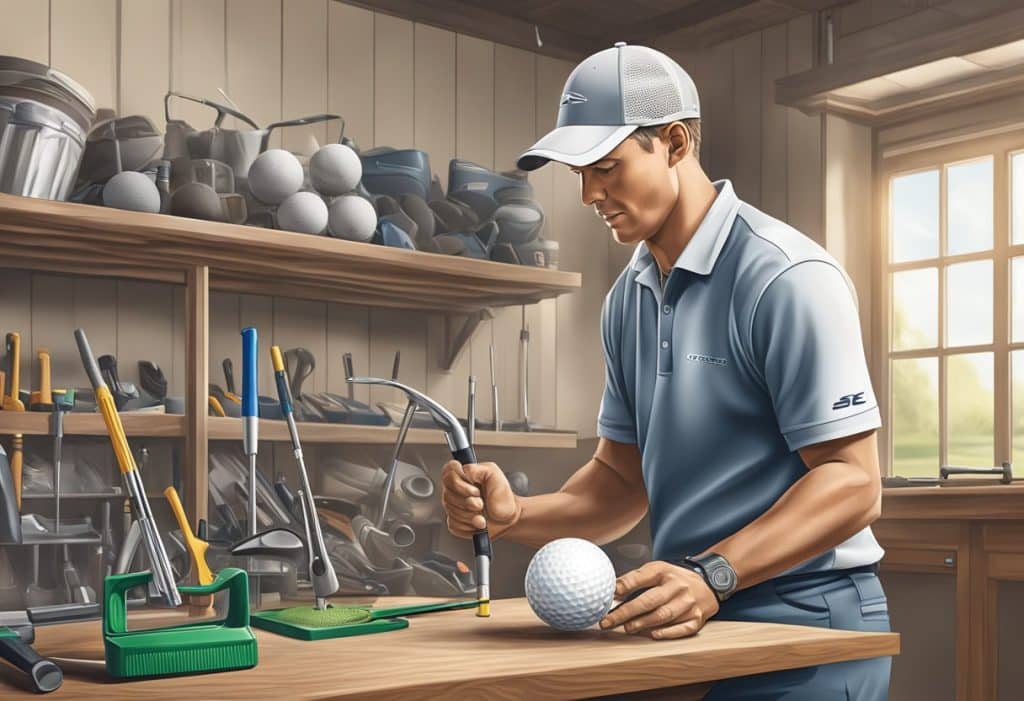Losing golf balls during a round can be frustrating and expensive. A golf ball retriever helps you get back those balls from water hazards, bushes, and hard-to-reach spots. Making your own DIY golf ball retriever can save money while creating a custom tool that fits your specific needs.
Building a golf ball retriever at home is simple and costs less than $5. With basic materials like PVC pipe or pool skimmers, golfers can create an effective tool that picks up balls without straining their back. The finished retriever helps collect free golf balls and tees while keeping players dry and comfortable.
Key Takeaways
- A homemade golf ball retriever can be built for under $5 using common household materials
- Custom retrievers help collect balls from water hazards and hard-to-reach places without getting wet
- DIY retrievers reduce strain on the back and save money on replacement golf balls
Understanding Golf Ball Retrievers
Golf ball retrievers help players save money and keep their favorite golf balls in play by reaching into water hazards, bushes, and other hard-to-reach spots on the course.
Purpose of a Golf Ball Retriever
A golf ball retriever stops players from losing expensive golf balls that land in tricky places. Premium golf balls can cost up to $4 each, making retrieval tools a smart investment.
The tools extend a player's reach by 6-18 feet to grab balls from water hazards without getting wet. They also help collect balls from thorny bushes and other challenging spots safely.
Many golfers use retrievers to build a collection of found balls for practice. This saves significant money over time and provides backup balls during rounds.
Types of Golf Ball Retrievers
Telescoping retrievers feature extendable poles with a scoop or grabber mechanism. These fit easily in golf bags when collapsed but can stretch out when needed.
Fixed-length retrievers offer sturdy construction for frequent use. While less portable, they provide reliable performance for dedicated ball hunters.
Common retrieval mechanisms include:
- Ring-style scoops
- Spring-loaded claws
- Cup-shaped nets
- Suction cup grips
DIY retriever options range from PVC pipe designs to modified pool skimmers, offering budget-friendly alternatives to commercial models.
Benefits of DIY Golf Ball Retrievers
Making your own golf ball retriever gives you control over the cost and design while getting a tool that meets your exact needs on the course.
Cost-Effectiveness
A DIY golf ball retriever costs significantly less than store-bought models, which can range from $20 to $100. The basic materials like PVC pipe and simple hardware typically cost under $10.
Creating your own retriever lets you save money that can be spent on other golf equipment or accessories. Many of the needed materials may already be available in your home or garage.
By building your own retriever, you'll also save money in the long run by recovering lost golf balls from water hazards and difficult spots. Premium golf balls can cost $4 or more each, so retrieving just a few pays for the DIY project.
Customization
Building a custom golf ball retriever allows you to adjust the length, grip style, and retrieval mechanism to match your preferences. You can make it exactly as long or short as needed for your local course's hazards.
The retrieval head can be designed to work best for your most common ball retrieval scenarios, whether that's from water hazards, bushes, or other tough spots. You can also modify the grip to be more comfortable for your hands.
The materials and colors can be selected to complement your golf bag and other equipment. Different attachments can be added or swapped out as needed.
Materials Required for DIY Golf Ball Retrievers
Building a golf ball retriever requires sturdy and lightweight materials that can extend to reach balls in water hazards and rough terrain. The two main components are PVC pipe and a telescopic pole, which provide durability and reach.
Choosing the Right PVC Pipe
PVC pipe serves as the main component for the retriever head. A 1/2-inch or 3/4-inch diameter PVC pipe works best for retrievers. The pipe should be at least 6 inches long for the head section.
A pipe cutter ensures clean, straight cuts for proper assembly. While a hacksaw can work, a dedicated pipe cutter creates more precise edges.
The pipe should be schedule 40 PVC, which offers the right balance of strength and weight. White PVC is recommended as it resists UV damage better than other colors.
Selecting a Telescopic Pole
The telescopic pole determines how far the retriever can reach. A pole that extends 12-15 feet provides good range while remaining manageable.
Aluminum poles are ideal due to their lightweight nature and resistance to rust. Look for poles with secure locking mechanisms to prevent collapse during use.
The pole diameter must match the PVC fittings. Most DIY retrievers use standard sizes that connect easily to 1/2-inch or 3/4-inch PVC attachments.
Choose a pole with comfortable grips and non-slip handles for better control when extended.
Construction Process
Building a basic golf ball retriever requires precise cutting and careful assembly of common materials. A clean PVC pipe and proper attachment points create a sturdy tool that can last for years.
Cutting and Shaping the Pipe
A DIY golf ball retriever starts with a 1/2 inch or 3/4 inch PVC pipe. A pipe cutter creates the cleanest cuts and safest edges.
Cut the pipe into two sections - a 4-foot main shaft and a 6-inch crosspiece for the retrieval head. Sand any rough edges smooth with medium-grit sandpaper.
Mark the center point of the crosspiece. Drill a 1/4 inch hole through this point for attaching the retrieval wire.
Assembling the Retriever
The retrieval mechanism connects to the crosspiece using strong wire or fishing line. Thread the wire through the drilled hole and create a loop that extends 2-3 inches below.
Secure the crosspiece to the main shaft at a 90-degree angle using PVC cement. Hold the pieces firmly for 30 seconds to ensure proper bonding.
Test the retriever's strength by picking up a few golf balls on flat ground before using it on the course. The wire loop should flex slightly but maintain its shape.
Enhancing Durability
A well-built golf ball retriever needs strong materials and proper protection from the elements to withstand regular use on the course. The right construction methods combined with weather-resistant treatments will keep your retriever working reliably for years.
Materials Durability
Strong metals like aluminum and stainless steel make excellent choices for the main pole. Avoid regular steel which can rust and weaken over time. The connection points between sections need reinforcement with metal collars or high-grade plastic joints.
The retrieval basket requires rigid wire mesh or durable plastic netting rated for outdoor use. Commercial retrievers can cost $20-100, but DIY versions can achieve similar durability with careful material selection.
Double-check all attachment points and test the strength before use. Apply metal epoxy or waterproof adhesive to secure loose components.
Weatherproofing Your Golf Ball Retriever
Water exposure poses the biggest threat to retriever longevity. A clear coat of marine-grade sealant or waterproof spray creates an effective moisture barrier. Pay special attention to protecting metal joints and connection points.
UV rays can degrade plastic components over time. Choose UV-resistant materials or apply a UV-protective coating to extend the life of plastic parts. Store the retriever in a dry place between uses.
Regular maintenance keeps problems from developing. Check for signs of wear or corrosion monthly. Clean the retriever after use in muddy conditions or water hazards.
Additional Features and Customization
A custom golf ball retriever needs comfort and reliability for frequent use. Smart design choices in both the grip and retrieval mechanism make a big difference in functionality.
Grip Enhancements
Adding tennis racket grip tape creates a comfortable, non-slip surface that works well in wet conditions. Custom golf grips can be made from rubber, foam, or textured materials.
Consider adding a wrist strap for extra security when reaching over water hazards. The strap prevents accidental drops into ponds or lakes.
Color-coding the grip area with bright tape makes the retriever easy to spot in golf bags or tall grass.
Retrieval Mechanisms
The most effective retrieval designs use flexible wire loops or sturdy netting material. Wire loops should be bent into a U-shape wide enough to cradle golf balls securely.
Adding small rubber tips to wire ends prevents scratching on golf balls. Some golfers attach multiple wire loops to increase the chances of successful retrieval.
Netting material needs secure attachment to prevent tearing. Reinforced edges and double-stitching at stress points extend the life of net-style retrievers.
A quick-release mechanism allows fast ball removal after retrieval. Simple spring clips or rotating catches work well for this purpose.
Safety Precautions in DIY Projects
Building a golf ball retriever requires careful attention to safety measures to prevent injuries and ensure proper tool handling. Proper safety gear and careful attention to measurements protect both the maker and the finished product.
Handling Tools and Equipment
Building a DIY golf ball retriever requires specific safety equipment. Wear safety glasses to protect eyes from PVC shavings and debris.
Keep work areas clean and organized. Remove obstacles that could cause trips or falls while handling tools.
Wear appropriate gloves when working with PVC cement or sharp tools. Keep tools sharp and well-maintained to prevent slipping or accidents.
Store tools properly after use. Place sharp objects pointing downward and away from walking paths.
Measuring and Cutting Safely
Mark measurement points clearly on materials before cutting. Double-check all measurements to avoid waste and unsafe corrections.
Use a proper cutting surface or workbench. Never cut materials while holding them in hand or on unstable surfaces.
Secure PVC pipes firmly when cutting. A pipe cutter works better than a hacksaw for clean, safe cuts.
Keep fingers at least 6 inches away from cutting points. Move slowly and deliberately when making cuts to maintain control.
Consider using a clamp or vise to hold materials steady. This provides better stability and keeps hands away from sharp edges.
Frequently Asked Questions
Building a DIY golf ball retriever requires basic materials and simple construction techniques. Smart design choices make these tools both functional and cost-effective for any golfer.
What materials are needed to build a homemade golf ball retriever?
DIY golf ball retrievers typically need PVC pipe, connectors, and a collection mechanism. A basic retriever uses 1/2 inch or 3/4 inch PVC pipe as the main shaft.
Common household items like pool skimmers, broom handles, and silicone tubes work well for the collection end.
How do I create a golf ball dispenser using DIY methods?
A golf ball dispenser needs a vertical tube with an angled base to control ball flow. PVC pipe works best due to its smooth interior surface.
Adding a simple release mechanism at the bottom allows for controlled dispensing of one ball at a time.
What are the dimensions for a PVC pipe suitable for a golf ball retriever?
Standard golf balls measure 1.68 inches in diameter. The ideal PVC pipe should be 2 inches in diameter to allow smooth movement.
The shaft length typically ranges from 6 to 12 feet for effective reach into water hazards.
Are there any step-by-step guides for constructing a golf ball picker?
Creating a golf ball picker starts with assembling the main shaft. The collection head attaches to one end using appropriate connectors.
The grabber mechanism needs testing to ensure proper ball retention without damage.
What is the process for making a golf ball sweeper using woodworking techniques?
Wood-based retrievers need weather-resistant hardwood for durability. The design includes a curved collection head with spaced tines.
Proper sanding and sealing protect the wood from water damage.
How can I design a golf ball retriever that's lightweight and portable?
Lightweight retrievers often use telescoping designs. Aluminum or lightweight PVC materials reduce the total weight.
Collapsible sections allow for easy storage in a golf bag.






